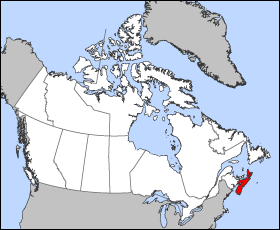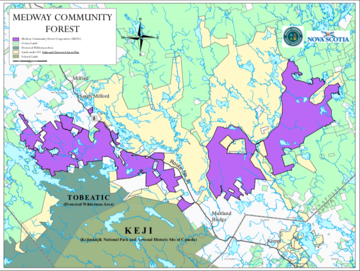Course:FRST370/Projects/Digging into Medway Community Forest in Caledonia, Nova Scotia, Canada: a case study of sustainable and ecologically based forest management to support local community investment
Medway Community Forest in Caledonia, Nova Scotia, Canada
Description
This case study will look at the Medway Community Forest in Caledonia, Nova Scotia, Canada. This page will examine whether or not the forest management they use is indeed sustainable and ecological. It will look into the different community involvements, starting with how the forest was found and determine how governance plays a role in this community. Then, the social actors will be identified in order to fully understand the background of the forest and where to implement improvements to the forest management to benefit the local communities. It is a crown land licensed area (from Canada) and the community forest land license is within The United Nations Educational, Scientific and Cultural Organization (UNESCO) Southwest Nova Scotia Biosphere Reserve (SNBR).[1] The SNBR works closely with local governments, businesses and communities to preserve natural and cultural heritage and they "creatively promote conservation and sustainable development which supports our local economies and communities".[1]
Medway Community Forest is Nova Scotia's first community forest that launched in 2015 and its area is 15,000 ha.[2] The resulting area is the best possible fit of considerations such as roads and access, forest type and volume, watersheds, current parcel boundaries, conservation and biodiversity values, recreation potential, and archaeological knowledge.[2] Past management of the forest resource in the area, primarily focused on meeting a pulpwood demand, has had significant influence on the available wood supply today. [2]
Community forests offer locals the management opportunities and "support social, environmental, and economic sustainability through: a) local decision-making, b) local economic resilience and benefit sharing opportunities, and c) sustainable forest uses (1)".[3] Nova Scotia has a Strategic Policy and Planning (SPP) branch which is responsible for:
- Coordinating business planning and accountability processes.
- Coordinating the on-going strategic planning process of the department.
- Developing and coordinating policy and planning processes and procedures.
- Serving as the focal point for planning and evaluation and developing plans related to the management of the department.
- Coordinating responses/representing the department on inter-departmental and inter-governmental requests/issues that are cross-sectoral or multi-sectoral in nature.
- Coordinating the preparation of background briefing documents/dossiers for the department including a consolidated database on benefits/impacts of natural resources.[4]
Based on this, sustainable and ecological forest management is plausible if the policies are enforced and regulated.
Tenure arrangements
The Medway Community Forest Co-op (MCFC) Crown land license area is located in Annapolis County near the communities of Annapolis Royal, Bear River, South Milford, Springfield, New Germany, and Caledonia.[2] On January 30, 2015, Zach Churchill, the Minister of Natural Resources in Nova Scotia, signed an agreement form with Will Martin, the Chair of Medway Community Forest Co-op. The community wanted a more direct opportunity to manage the forest. By having the community forest, locals are able to manage their own resources in a way that is sustainable and up to standards. This is an example of Joint Forest Management (JFM) like that in West Bengal, India which was discussed in one of the FRST370 lectures. The purpose of this community forest is to invite the local communities as shareholders to the Co-op by using their collective knowledge and experience to create forest ops jobs and have economic decisions with forest management. This short clip shows a little bit of the launching of Nova Scotia's first community forest. They have the Forest Utilization License Agreements (FULA) and the license holder is the Co-op with a registered office at Kempt, Queens County.[3] The closure of Bowater led to the Medway Operating Agreement Plan which gave the community forest an annual allowable cut (AAC) of about 22,000 tonnes.[5] There are rights and responsibilities given to some community forests over 'ecologically sensitive areas' (12).[6] The Co-op at Nova Scotia has been entrusted with this.
Administrative arrangements
MacLellan wrote that “about 50% of the forest land is owned in small parcels, or woodlots, by individuals and small family companies. About 20% is owned in larger holdings by large firms. The remainder - about 30% - is Crown land" [7] There is much community involvement as a good chunk of work comes from the local community. They are aware of the responsibilities and they are more than eager to participate. MacLellan also defined commercial activity as 'an asset to the implementation of a community forest model in Nova Scotia.” [7] The SPP are developing a working management plan for the MCFC heavily based on the existing Medway District Management Plan[8] and from this, harvesting can be controlled and regulated. After monitoring, the community can have access to improve its harvesting strategies.
Social Actors
Social actors in the community forest are:
- MCFC
- Minister of Natural Resources
- Local communities at Queens County
- SNBR
- UNESCO
- Government of Nova Scotia
- Shareholders of the forest
- Board of Governance representing a balance of interests (environment, economics, community, and members- at-large)
Various committees including:
- Operations,
- Community Outreach,
- Governance,
- Business Development & Finance[8]
Forest Management
The decision making for ‘community boundaries’ is the most crucial when talking about the tenure in Nova Scotia.[9] Setting boundaries between the community forest and the public forests will ensure a more regulated harvesting. According to the State Forest, “Nova Scotia Department of Natural Resources (NSDNR) forest inventory personnel have been continually tracking many elements of the forest for over 50 years” (6).[10] The forest in Nova Scotia had been carefully monitored to make sure that the forest is managed as sustainably as possible. Because this community forest has only been recently established, there is not much data available to be gathered.
There is also the forest practices review policy as mentioned by Lahey which debriefs on, but not limited to:
- Acts, regulations, and the Natural Resources Strategy
- The state of Nova Scotia’s forests
- Biodiversity in Nova Scotia
- Forest industry overview
- Code of Forest Practice and ecosystem‐based planning
- Ecosystem‐based planning tools
- Historical and current trends in wood supply[11]
Another factor that is used to manage the forest is through community outreach and newsletters. [12] This allows for the community to keep in touch and be updated with any news regarding their forest. A negative aspect of this community forest is road work. Road work results in ground disturbance and audits needed to be compiled by harvesting method, harvesting system, and soil type in each administrative region.[10] These data can then be shared with the Co-op to come up with alternative solutions that will better manage the forest while still involving the community.
The community forest have followed the regulations closely and have been sustainable in their harvesting. It can be concluded that they have kept their promises in the three-year policy they have agreed to and their forest management plan does benefit the local communities. This had been a successful launch of Nova Scotia's first community forest.
Recommendations
Some recommendations include:
- Future planning for success[12]
- After their 3-year term, they can look back and assess how they can improve on their standards and communication with the locals.
- Discuss financing and the future[9]
- This Joint Forest Management requires hard work and support from the Government as well as other stakeholders. Financial and budgeting should be discussed before and extension of the terms.
Finally, the Co-op could fund innovative programs and strategies such as new models of forest tenure for increased community involvement that were initiated by the local community. New programs could include the redistribution and reorganization of tenure rights and AAC allocations for non-industry interests, as well as the establishment of new partnerships, ensuring available and culturally appropriate access to timber resources.[3]
References
- ↑ 1.0 1.1 "Southwest Nova Biosphere Reserve".
- ↑ 2.0 2.1 2.2 2.3 "Community Forest Area".
- ↑ 3.0 3.1 3.2 Bullock, R. and Lawler, J. (2016) Briefing Note: Community Forestry in Canada. Winnspace: University of Winnipeg.
- ↑ "Government Nova Scotia".
- ↑ "Medway Community Forest Co-op".
- ↑ Teitelbaum, S. (2016) Community Forestry in Canada: Lessons from Policy and Practice. Vancouver: UBC Press.
- ↑ 7.0 7.1 MacLellan, L. K. and Duinker, P. (2012) Community Forests: A Discussion Paper for Nova Scotians. Dalhousie University, Halifax and Nova Forest Alliance, Stewiacke.
- ↑ 8.0 8.1 https://www.nsfm.ca/unsm-2016-forestry-workshop-presentations/470-medway-community-forest/file.html
- ↑ 9.0 9.1 Duinker, P. N., et al. (1994) Community Forests in Canada: An Overview. The Forestry Chronicle. 70(6), 711-720.
- ↑ 10.0 10.1 State of the Forest. (2017) Nova Scotia Department of Natural Resources Renewable Resources Branch. Province of Nova Scotia. https://novascotia.ca/natr/forestry/reports/State_of_the_Forest_2016.pdf
- ↑ Lahey, W. (2018) An Independent Review of Forest Practices in Nova Scotia: Addendum. University of King’s College, Halifax, Nova Scotia.
- ↑ 12.0 12.1 MacLellan, L. K. (2013) Guide to Community Forests in Nova Scotia. Nova Forest Alliance, Stewiacke.
| This conservation resource was created by Christian Surniawan. |







